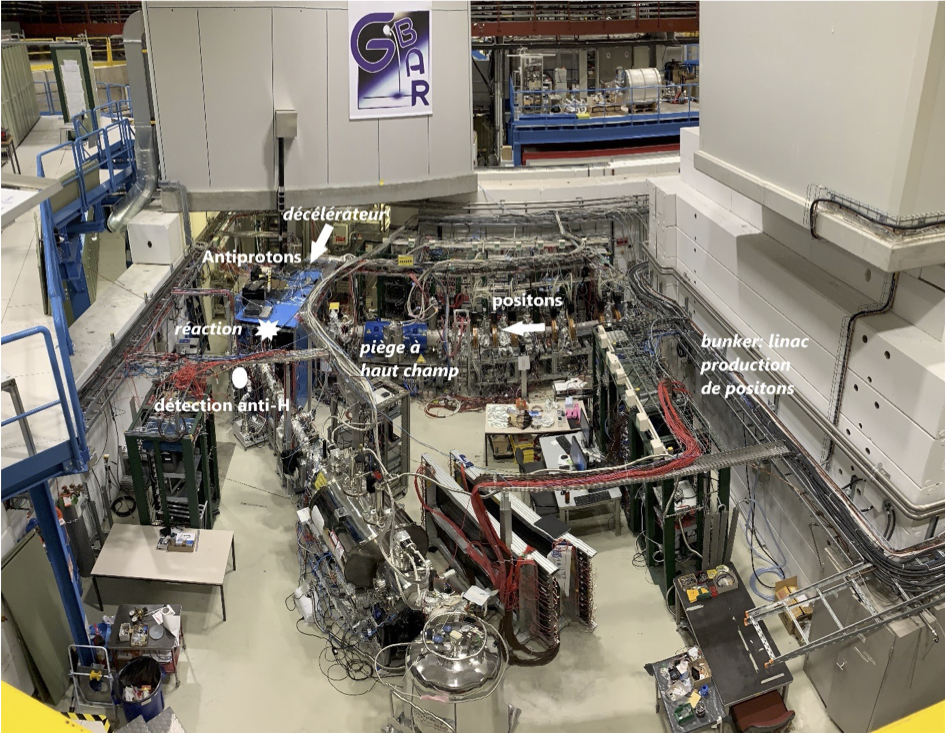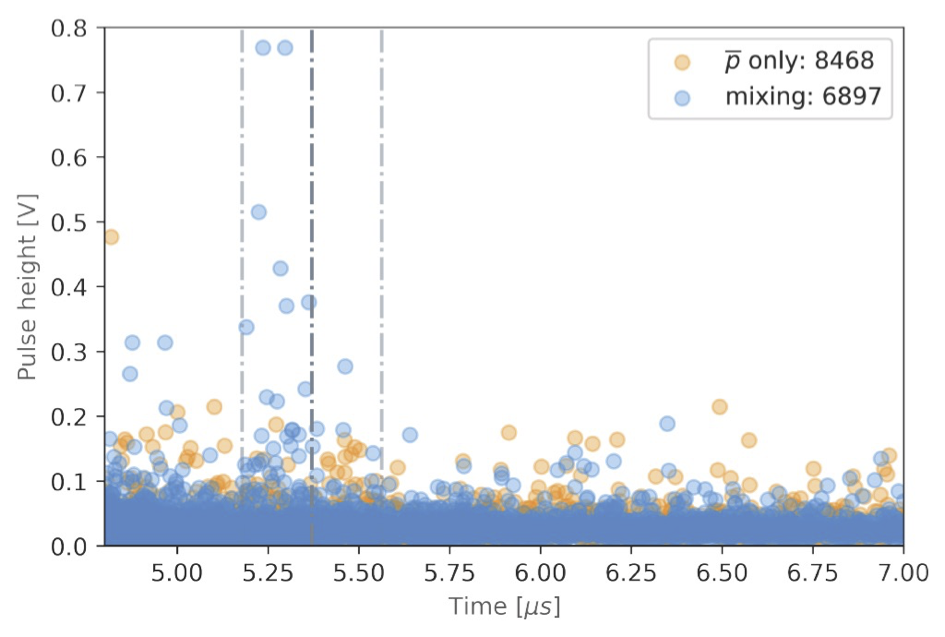
The GBAR experimental zone at CERN. The directions of the antiprotons (coming from ELENA, above) and positrons (produced by an electron linac, protected in the bunker on the right) are shown, as well as the location of the reaction chamber and the antihydrogen detection point. The line in the foreground is the embryo of the future line for positive anti-hydrogen ions. It is currently being used to test an antiproton trap, which will be inserted before the reaction chamber this year.
The GBAR collaboration, to which the IRFU makes a major contribution, presented the results of its first data collection at CERN at the end of 2022 at the Moriond conferences in March 2023. For the first time, it observed the production of anti-hydrogen atoms resulting from the interaction of a beam of antiprotons supplied by CERN's Antiproton Decelerator (AD) and decelerated to an energy of 6 keV, with a cloud of positronium produced locally in the experiment. GBAR thus joins the very select club of experiments that have successfully synthesised anti-hydrogen atoms!
The ultimate aim of the GBAR experiment is to measure the acceleration of an anti-hydrogen atom in the Earth's gravity field, and compare it with that of ordinary matter. The Equivalence Principle, the basis of Einstein's General Relativity, states that all forms of matter and energy behave in the same way with respect to gravity. Since Galileo, falling-body experiments have tested this principle for different chemical elements of ordinary matter, confirming it with increasingly precise agreement. Recently, the MICROSCOPE satellite experiment verified it with a remarkable uncertainty of one part in 3x1015. But the action of gravity on antimatter has never yet been measured! Several indirect arguments suggest that antimatter should respect the Principle of Equivalence, and should therefore "fall" towards the Earth like matter. However, the relationship between matter and antimatter is intrinsically quantum, and the theory of gravitation does not sit well with quantum theory. So only experimental measurement can remove this doubt. Of course, the first step is to measure the sign, i.e. whether antimatter 'rises' while matter 'falls'. But even a small quantitative difference between the acceleration of antimatter and matter in free fall would be a revolution in physics
Preparing an anti-atom slow enough to see it fall is no easy task, and the path chosen by GBAR involves several stages, including the production of a positive anti-hydrogen ion (the antimatter equivalent of an H- ion) and its slowing down using quantum optics techniques.
The first step, recently completed, is to make anti-hydrogen atoms from antiprotons produced by AD and positrons produced in GBAR. The antiprotons from the AD (with an energy of 5.3 MeV) are decelerated and conditioned by the ELENA ring, and a packet of a few million 100 keV antiprotons is sent to GBAR every two minutes. In GBAR, a slip drift tube further decelerates this packet to an adjustable energy ranging from a few keV to 10 keV. In parallel, in another part of GBAR, a linear accelerator (linac) sends 9 MeV electrons onto a target, where their interaction produces positrons. These positrons are recovered and accumulated in a series of electromagnetic traps. Just before the packet of antiprotons arrives, the positrons are sent to a layer of nanoporous silica, where around one in five binds with an electron to emerge as positronium (Ps). When the packet of antiprotons crosses the Ps cloud, a charge exchange can take place: the positronium gives up its positron to the antiproton, which becomes an anti-hydrogen.
In 2022, GBAR operated for the first time with positron and antiproton beams. Data acquisition is sequenced by antiproton pulses from ELENA every two minutes. In 'mixing' mode, around 5x107 positrons are extracted from the last trap and sent onto the nanoporous silica, producing a cloud of around 7x106 positroniums. This cloud is crossed by approximately 3x106 antiprotons. After the reaction chamber, a series of electrostatic deflectors push aside the antiprotons that have not interacted, leaving the neutral antihydrogens to propagate in a straight line to an MCP (Multi-Channel Plate) detector.
The detector is also sensitive to certain pion impacts from antiproton annihilations, which constitute background noise. We are therefore also recording data in 'anti-p only' mode, under identical conditions for antiprotons but without injecting positrons, in order to compare measurements.
At the end of 2022, after several months of adjustments, GBAR took data over 6 weeks, recording around 7,000 pulses in 'mixing' mode and 8,500 in 'anti-p only' mode. The analysis is based on the amplitude and arrival time of the electrical signal measured in the detector. It is expected that the anti-hydrogens will give large signals, and that their arrival time will be within a range compatible with their time of flight from production.

The figure above shows for all pulses the voltage of the largest signal as a function of its arrival time. The vertical lines mark the expected time window. We can clearly see an excess of large signals for the mixing pulses (in blue) compared with the "anti-p only" pulses (in orange). The statistical significance of this excess is between 3 and 4 standard deviations, depending on the selection criteria used.
For GBAR, after this first essential step, we now need to increase the number of anti-hydrogen atoms produced. This will first enable precision measurements to be made on the anti-hydrogens themselves, in particular an energy gap between two very specific atomic levels: the Lamb shift. Comparison with the known value for the hydrogen atom is a test of matter-antimatter symmetry for the electromagnetic interaction, and any difference, however small, would be a sign of new physics.
This will be followed by the production of positive anti-hydrogen ions, which will require even greater performance from the two beams and their combination, and finally the implementation of the optical system (lasers) for cooling these ions and photo-detaching a positron, to finally observe the free fall of an ultra-slow anti-hydrogen atom.
Several experiments that have been running for several years at AD have already produced anti-hydrogens. Some have been able to trap these atoms and carry out precision measurements of their electromagnetic properties, but not yet of their behaviour with respect to gravity. The ALPHA collaboration has equipped itself with a new facility for this measurement and could give an early indication of the sign of acceleration, i.e. whether the antimatter is rising instead of falling! AEgIS is also in the running.
But in the long term, the method envisaged by GBAR could offer unrivalled precision for comparing antimatter and matter. The speed of anti-hydrogen could be reduced sufficiently to allow the use of a quantum interference method that has already been successfully implemented with ultra-slow neutrons. The relative uncertainty in the measurement of gravitational acceleration could then be reduced to 10-3, or even better.
More information on GBAR website
• The ultimate constituents of matter
• Institute of Research into the Fundamental Laws of the Universe • The Electronics, Detectors and Computing Division • The Particle Physics Division
• GBAR
